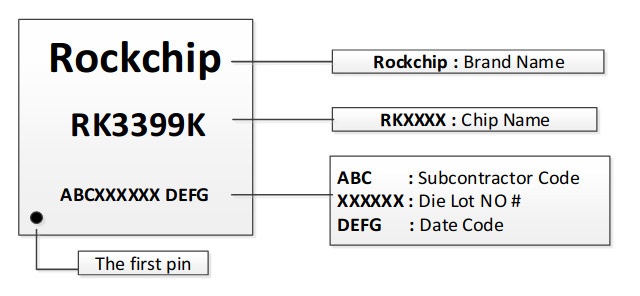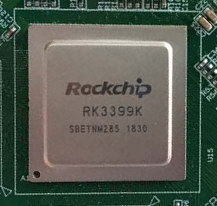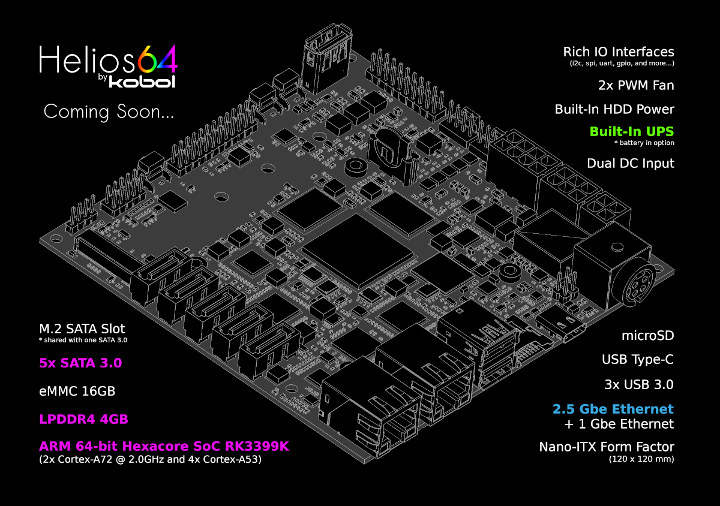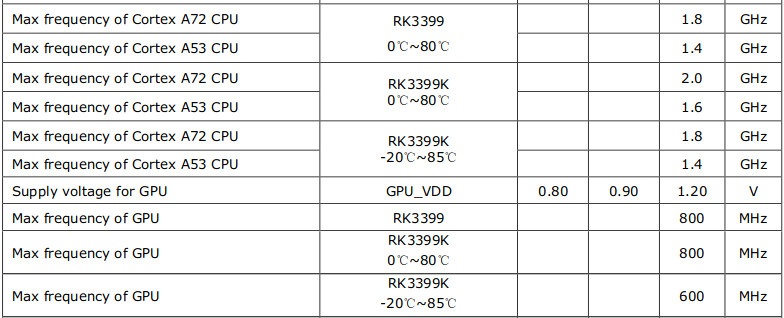First unveiled in 2016, Rockchip RK3399 hexa-core processor is still widely used in development boards, Android mini PCs and Chromebooks. But today, I’ve come across another variant.
Rockchip RK3399K has exactly the same features but either supports higher clock CPU clocks (Cortex-A72 @ 2.0 GHz, Cortex-A53 @ 1.6 GHz), or wider temperature range between -20°C and 85°C with lower clock speeds for the CPU (A72: 1.8 GHz, A53: 1.4 GHz) and the GPU (600 MHz)
I think I’ve read stories about Rockchip RK3399 being clocked at 2.0 GHz with proper cooling, but it may not be reliable on all boards. RK3399K should fix that.
Rockchip actually updated its datasheet on the 29th of May, but I only found out about it today. Everything else looks the same, and you’ll be able to find out whether your device uses RK3399 or RK3399K by looking at the marking on the chip.

 That’s all info there’s in the datasheet about RK3399K. A web search does not return any board or another hardware platform (in English) based on the new processor.
That’s all info there’s in the datasheet about RK3399K. A web search does not return any board or another hardware platform (in English) based on the new processor.
Instead, I learned about the new processor via Kobol. You may remember Kobol Helio4 DIY NAS powered by Marvell ARMADA 388 dual-core processor, and the company is now working on Helio64 nano-ITX board featuring Rockchip RK3399K processor @ 2.0 GHz with some interesting features.
Preliminary specs as follows:
- SoC – Rockchip RK3399K hexa-core processor with 2x Arm Cortex-A72 cores @ 2.0 GHz, 4x Cortex-A53 cores @ 1.6 GHz
- System Memory – 4GB LPDDR4
- Storage – 16GB eMMC flash, 5x SATA 3.0, 1x M.2 SATA slot (shared with one SATA 3.0 port), MicroSD port
- Connectivity – 1x 2.5GbE port, 1x Gigabit Ethernet port
- USB – 3x USB 3.0 ports, 1x USB type-C port
- Expansion – Headers for I2C, UART, SPI, GPIOs…
- Misc – 2x PWM fan headers, RTC with backup battery, buzzer
- Power Supply – Dual DC inputs, built-in UPS support with optional battery.
- Dimensions – 120 x 120 mm (nano-ITX form factor)
 It will take a while before the board becomes available however, as I’ve been told the PVT (Production Validation Test) samples are expected sometimes in December meaning the board and/or NAS Kit will likely be available in the first part of 2020.
It will take a while before the board becomes available however, as I’ve been told the PVT (Production Validation Test) samples are expected sometimes in December meaning the board and/or NAS Kit will likely be available in the first part of 2020.
I could also notice an industrial computer and a system-on-module based on Rockchip RK3399K on some Chinese websites. Both products were apparently announced last year (2018), so the upgraded processor has been available for some time, but Rockchip may not have actively promoted this version until recently.

Jean-Luc started CNX Software in 2010 as a part-time endeavor, before quitting his job as a software engineering manager, and starting to write daily news, and reviews full time later in 2011.
Support CNX Software! Donate via cryptocurrencies, become a Patron on Patreon, or purchase goods on Amazon or Aliexpress





btw Raspbery pi 4 is overclock-able to 2148MHz now 🙂
with latest firmware
It’s interesting to see that they are stuck at this limit which is exactly the highest frequency in hertz you can express on a signed 32-bit int (2147483648 to be precise). I used to have exactly the same issue on the MiQi (RK3288) two years ago. Thus I don’t expect any muve beyond this limit for a while, until they figure where there’s a nasty signed vs unsigned limitation somewhere in the code 🙂
It’s a curious bord. I guess they are using 2 PCIe lanes for the 2.5 Gbe Ethernet and then only 2 lanes for the 5 SATA ports. Why the 2.5 Gbe though? It’s not exactly wide spread 😀
But I guess if you want to add SATA you have the choice of 2 or 4 lanes. And if you also want to add Ethernet you have to go with 2 lanes SATA and the rest for Ethernet. Maybe they could have gone with 1 Gbe and use only one lane and the last lane for something else? This board depends hard on its price. If I want more then 1 Gbe Ethernet and a couple of SATA ports it might be cheaper to go with X86 instead and use a cheap 10 Gbe PCIe card…
2.5Gbps is the “new” standard for prosumer hardware. Most mid to high-end PC motherboards are featuring 2.5Gbps now.
I’m curious what the SATA controller is, as there’s no five port SATA controller that I know of, so this must either be a four port and a single port or something else that I’m not aware of. It’s possible they use a port multiplier, but it doesn’t really make sense either…
My issues is with the form factor, there are no readily available nano-ITX NAS cases, whereas there’s a bunch of mini-ITX NAS cases. Talk about missing an obvious “feature”…
Wrt form factor: “We will sell a simple adapter kit in order for people to use Helios64 with any mini-ITX and ATX PSU” (this way low consumption will be impossible but hey…)
SATA controller could be a JMB585 which is a Gen3 x2 controller so OK for spinning rust but in combination with RK3399 (Gen2) definitely a bottleneck for SSDs.
But is there consumer network gear with 2.5 Gbe? I would buy 2.5, I would go straight to 10 which is getting al lot cheaper these days.
For cases, I know of these two:
https://geizhals.de/inter-tech-ipc-sc-4100-88887112-a1215437.html?hloc=at&hloc=de
https://geizhals.de/inter-tech-ipc-sc-4004-88887186-a1485329.html?hloc=at&hloc=de
But I don’t know how readily available these are elsewhere…
> But is there consumer network gear with 2.5 Gbe?
If you consider the 2.5/5/10 GbE ports ‘server uplinks’ it starts at less than 200 bucks: https://geizhals.de/?cat=switchgi&xf=16696_1
For testing purposes I have a MS510TX on my desk to be combined with RTL8156 USB3 dongles or Macs with their ACQ107 NBase-T network chip (2.5/5/10 GbE). With most use cases 5GbE or 10GbE bandwidths are more than enough (I only sometimes see 10GbE links with more than 25% utilization in various installations) while 2.5GbE links can and will be saturated even with use cases like ‘home NAS’.
> Why the 2.5 Gbe though?
Since it’s great?
Same cabling as with Gbit Ethernet but 2.5 times the speed. And no, you don’t get ‘almost the same’ with bonding as many hobbyists still think. And now with 2.5GbE gear that is not just castrated 10GbE equipment also consumption numbers are way lower compared to 10GbE.
Wondering how Helios64 implements 2.5GbE Ethernet… USB3 attached (RTL8156) maybe with an USB hub involved in between oder using a PCIe switch? The SATA ports will most probably be provided by a JMicron JMB585?
I think the RK3399 was initially announnced as 2.0+1.5 (that’s what we used to see everywhere) then when products actually started shipping it went down to 1.8+1.4, except many TV boxes announcing 2.2 of course 🙂 This SoC is not the most power-efficient thing on earth, but they probably managed to improve the yield quality and get way more samples running fine at 2.0.
In my Neo4 farm, I finally limited the A72 cores to 2.0 (the performance difference on the A72 was not enough and they were cooking the A53 ones limiting their frequency while they do half of the job). One of the boards has all A53 cores stable at 1.7 even when burning hot (throttling is set to 100°C), 3 are OK at 1.6 and one is only at 1.5. So overall I’d say that 100% of my devices are stable at 100°C with 2.0+1.5 and some slight overvoltage. Thus I’m not surprised they finally managed to make these new operating points official.
> I think I’ve read stories about Rockchip RK3399 being clocked at 2.0 GHz with proper cooling
My understanding is that Rockchip did a chip selection after fab QA: Those RK3399 that were able to clock high at lower VCore voltages were sold as OP1 to Google for their Chromebooks, those that needed higher voltages to run stably became RK3399.
The former ‘specified’ for 2.0/1.5GHz, the latter for 1.8/1.4GHz and both having their own DVFS tables with lower voltages for the OP1 variant which could then reach the higher clockspeeds while generating same amount of heat as the RK3399 variants at lower clockspeeds.
I’ve not encountered any problems when clocking RK3399 up to 2.0/1.5GHz using the DVFS table for this variant meaning a lot higher voltages to feed the CPU cores at the highest clockspeeds also resulting in a lot more heat. Problems only with boards with insane powering methods like ‘dumb’ USB-C in 5V only fashion like on NanoPi M4 and NEO4. Here the higher consumption of the RK3399 when allowed to reach the upper clockspeed limits results in voltage drops on the DC power rail and can cause instabilities.
At least the M4 can be powered via their hats. They even introduced a “power hat” 😀
https://www.friendlyarm.com/index.php?route=product/product&product_id=256&search=psu&description=true&category_id=0
The USB-C connector works way better for me than the older micro-usb jokes. Type-C connectors are rated for 3A under 5V, which means dropping no more than 0.25V there. They comme with 4 times the number of power lines as micro-usb so the situation improved a lot. I think most remaining issues is with users having poor power supplies, “rated” at 2A/2.5A while dropping voltage to less than 4.5V under such a current. The real issue then is for users who can’t check this by themselves and who run into trouble when connected to their $2 phone charger :-/
Edit: it’s even 5A rating and 40mohm max per pin, so that leaves plenty of margin: https://www.usb.org/sites/default/files/USB_Type-C_Compliance_Document_rev_1_2.pdf
> USB-C connector … it’s even 5A rating
Doesn’t change a single bit that SBC users grab a very long USB-A to USB-C cable and connect a crappy PSU (either providing 5V or 4A but never both at the same time) with their board and suffer from freezes and crashes.
With the M4 users actually have to show some PSU diligence, as most usb-c PD PSU’s will not power the M4 due to lack of basic negotiation skills in the M4.
> My understanding is that Rockchip did a chip selection after fab QA: Those RK3399 that were able to clock high at lower VCore voltages were sold as OP1 to Google for their Chromebooks, those that needed higher voltages to run stably became RK3399.
That’s correct — there’s stock-vs-OP1 binning, and the OP1 chips are marked accordingly on their lid.
For awhile back in 2018 this was on sale online K10 Plus Android 7.1 Smart TV Box RK3399K 4G+32G Quad Core 4K HD Streaming Media
Posted on July 24, 2018
No ECC? That was the novel detail with the Helios products. Without ECC I’ll stick with my M-ATX Gemini Lake board with a cheap LSI SAS2008 reflashed board. 10 total ports for my spinning rust.
> No ECC?
We will offer an ECC option. The Rockchip RK3399 SoC itself doesn’t have a memory controller that has ECC feature, however we are currently working with a SDRAM vendor that now offer built-in ECC feature inside the SDRAM directly. It’s not impossible it will be available on day one
So there will be an option with on-die ECC LPDDR4 which is not that surprising since JEDEC already said a long time ago that with future fab nodes ECC will be optional/mandatory with mobile DRAM … and it also helps with power consumption — see for example: https://www.micron.com/-/media/client/global/documents/products/white-paper/ecc_for_mobile_devices_white_paper.pdf
For me one requirement for server grade ECC RAM is the possibility to read out bit flips (EDAC) so you know when a RAM module starts to go bad being able to replace it. Though with LPDDR you would need to desolder modules but at least know that’s something wrong with the module long before uncorrectable 2-bit errors result in the same we see with single-bit errors on non-ECC RAM…
> For me one requirement for server grade ECC RAM is the possibility to read out bit flips (EDAC) so you know when a RAM module starts to go bad being able to replace it
Does on-die ECC report error conditions back to the controller at all?
> Does on-die ECC report error conditions back to the controller at all?
At least not with an RK3399 or any other memory controller that is not aware of ECC. Single-bit errors get corrected on the fly without the host even noticing and double-bit errors result in the same we see today with single-bit errors on non-ECC memory: ranges from nothing over data corruption to application crashes to system freezes depending on where the bit flip happens.
JEDEC talked 5 years ago about ‘on die ECC’ ‘for future DRAM process (vendor specific / transparent spec). I guess this on-die ECC trend is simply the result of memory becoming less reliable with higher density.
Ok, I misread you original post then — I thought you meant it could, and I was wondering if some obscure JEDEC protocol allowed that on LPDDR4.